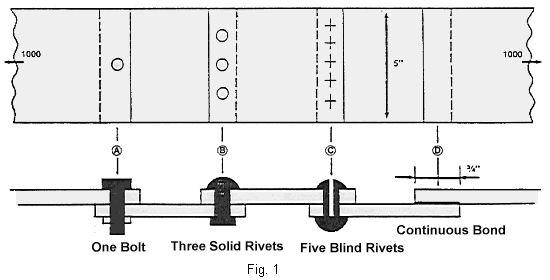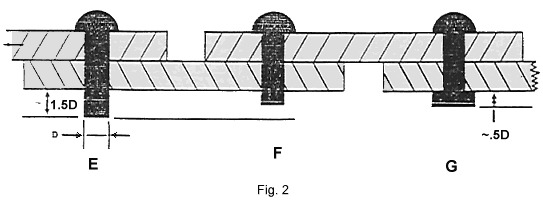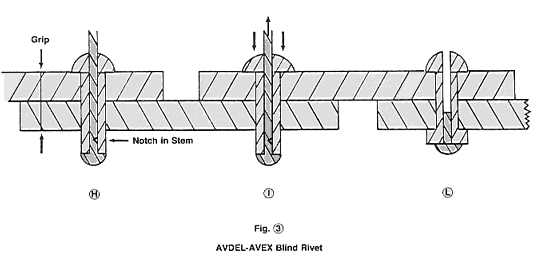Aircraft raw materials come in different but limited sizes due
to manufacturing limitations as well as economical distribution. The designer
has to choose materials which are available, can be transported to the
manufacturing facility (even the homebuilder's basement or garage), can be cut
to required sizes with the minimum tools, and can be handled without causing too
many rejects due to mishandling ... and still end up with an aircraft of
appreciable size, adequate strength and good looks. Aircraft can't just be made
out of one big sheet of material and "wrapped together." Rather, various parts
have to be formed out of different types of material and joined together. Each
of those parts carries a load and the fastener that brings these parts together
has to carry the load from one part to the other. If we have, for example, 1,000
lbs. to be carried over from one skin to another, we can choose various ways of
achieving this (see figure 1).
The designer of an aircraft chooses the solutions best adapted
to the materials used - a continuous joint with wood and composites, a single
bolt or heavy (thick) fittings with steel; or riveted joints on relatively light
gauge materials and/or when the joints are long (to avoid the weight penalty of
many steel bolts).

For over 50 years, riveted
aluminium structures have been very
successful, and are found to varying degrees on virtually all aircraft (whether
the complete airframe or just an instrument panel). They do not fail under
static or repeated loads and they do not corrode if the rivets are well chosen
and properly set.
How to set the rivets correctly can be learned quite easily and
should be explained by the designer when he sells drawings or kits to build an
aluminium aircraft. The choice of rivets is very simple: only 2017 alloy rivets
are commercially readily available (these are the "AD" rivets mentioned in
earlier columns). They have good corrosion resistance and are compatible with
2024 and 6061 materials.
Now, let's look at why they are also a good structural
fastener. (See figure 2). First the hole is drilled slightly oversized (via the
use of number drills) so that the rivet can easily be introduced after deburring
(see Figure 2, item E).

Note that the drawing also indicates correct rivet size
depending on the total metal thickness, called the "grip'. Then the rivet is
squeezed (compression is achieved by a rivet 'gun" and a "bucking bar". The
pneumatic gun hammers on one side while the bucking bar, which is simply a heavy
chunk of steel, provides the reaction on the other.)
When the rivet shank is compressed, its diameter grows until
the hole is completely filled. (See Figure 2, item F). When we further compress
the rivet it can only grow further outside the hole and thus the formed head is
shaped (see Figure 2, item G), which also gives a correct formed head dimension.
Note that a visual inspection of the rivet will immediately tell you if the
rivet is good or if it has to be drilled out and replaced.
Such easy inspection is obviously not possible on a bonded or
glued joint, which can cause such joints to be less reliable.
Next, let's look at what makes the set rivet (AD rivet) a good
fastener.
 First, AD rivets are manufactured with adequate quality
control which guarantees you the correct alloy (when you mix bonding cement or
resins. you are responsible!)
First, AD rivets are manufactured with adequate quality
control which guarantees you the correct alloy (when you mix bonding cement or
resins. you are responsible!)
 The rivet fills the hole completely so that no relative
motion is possible.
The rivet fills the hole completely so that no relative
motion is possible.
 The original as well as the formed head both rest both very
well an the parts having been compressed into place. This makes for a snug and
sealed joint which will prevent any water from creeping under the heads and
corroding underneath.
The original as well as the formed head both rest both very
well an the parts having been compressed into place. This makes for a snug and
sealed joint which will prevent any water from creeping under the heads and
corroding underneath.
Also very important is the fact that the heads squeeze
assembled parts tightly together and when the loads are applied (see arrows on
Figure 2), part of the load is transmitted from one sheet to the other by
friction. It just happens in aircraft (this is not the case with racing cars)
that the part of the load transmitted by friction corresponds to the high
frequency engine loads which would otherwise fatigue the rivet (or require an
overdesign of the rivet joint which is done in racing cars where the engine
vibration loads are much larger with respect to the static loads). As mentioned,
solid riveting when correctly done is an excellent fastener - both reliable and
durable. But it also has some drawbacks:
 You need special equipment (you'll need to buy an air
compressor, rivet gun(s), rivet snaps and bucking bars);
You need special equipment (you'll need to buy an air
compressor, rivet gun(s), rivet snaps and bucking bars);
 You need some expertise and prior practice (you'll need a
good teacher for this - errors can be costly in more ways than one);
You need some expertise and prior practice (you'll need a
good teacher for this - errors can be costly in more ways than one);
 It is noisy (your family and
neighbours may object to your
setting rivets in your basement or garage after 10 p.m. or on Sunday morning .
. . and that is just when you have the time for it);
It is noisy (your family and
neighbours may object to your
setting rivets in your basement or garage after 10 p.m. or on Sunday morning .
. . and that is just when you have the time for it);
 You need access to both sides of the parts to be assembled
(and this is obviously not always easy or possible: How will you get the
bucking bar inside an aileron of a small aircraft?). You'll often need a
helper to "buck" the rivet on the other side, or have long skinny arms and/or
a full assortment of bucking bars.
You need access to both sides of the parts to be assembled
(and this is obviously not always easy or possible: How will you get the
bucking bar inside an aileron of a small aircraft?). You'll often need a
helper to "buck" the rivet on the other side, or have long skinny arms and/or
a full assortment of bucking bars.
So another solution has been devised - blind rivets, which have
none of the above-mentioned disadvantages. Blind rivets, often incorrectly
referred to as "pop" rivets, have been used on aircraft since the production of
the DC-3 (the tubular 'Chobert' rivets). In the next article we will discuss the
good and also the questionable qualities of blind rivets in more
detail.
In the first part of this article we examined the advantages
(i.e. reliability and durability) of solid "bucked" rivets as well as their
disadvantages (i.e. need for expensive equipment, required skill level, noisy
operation, and accessibility). Blind rivets have been developed to overcome the
disadvantages of solid rivets, and some of the blind rivets now available have
retained virtually all the advantages of solid rivets. Let's look at blind
rivets in some detail.
First of all, let us understand that a "pop" rivet is a blind
rivet, but a blind rivet is not necessarily a pop rivet. ("Pop" rivet is a brand
name manufactured by USM - United Shoe Machine - and obviously a "shoe" rivet is
not ideal for aircraft use.)
As a typical example, we will use Textron's Avdel Avex rivet
(see Note at end of article).

When setting a blind rivet we first drill a slightly oversize
hole so that the rivet can easily be inserted (see item H, Figure 3).
A special hand rivet puller (hand rivet gun from a local
hardware store - at $15 to $50, depending on quality) is used to pull on the
rivet stem and the reaction is applied to the rivet head. The stem has a special
head which compresses the rivet tube and makes it grow and fill the hole (see
item 1, Figure 3) pulling further. The rivet can only grow outside the parts
until the rivet and stem head create a good formed head resting well on the part
and squeezing the parts together. At that stage, the stem breaks in tension at
the notch. (The set rivet is shown in item L, Figure 3.)
When we examine this blind rivet and compare it to the solid
rivet discussed in Part 1 of this discussion, we find some of the same
advantages:
The rivet is manufactured under adequate quality control, which
guarantees you the quality. (Again, see note at the end of this
article.)
The rivet fills the hole completely preventing any relative
motion.
Original and formed heads seal on and compress the parts
together (no corrosion, the engine vibration loads do not fatigue the rivet
because they are transmitted by friction.)
There is one prime disadvantage to blind rivets. The rivet,
being tubular, has a section that is obviously smaller than that of a solid
rivet. This means one blind rivet is not as strong as one solid rivet of the
same diameter. The designer needs more blind rivets, a larger diameter rivet or
a stronger material.
Many designers seem to like the "monel" (stainless
steel type) rivets which are stronger, but they may forget that there is a
corrosion problem involved with stainless steel. As mentioned in an earlier
article, as the aluminium corrodes away, the aircraft owner has no choice but to
replace the rivet with a larger diameter rivet later on. Or, if using stainless
steel rivets, the builder has the messy burden of dipping every single rivet in
zinc-chromate (ZnCr) primer before setting it in the hole ... and this is all
beside the fact that there is no "good" stainless steel blind rivet readily
available on the market!
Going to larger rivet diameters is a limited choice as the
large blind rivets are so hard to set by hand that a very expensive and
cumbersome tool is required. In my opinion, this defeats the purpose of these
rivets in the first place.
Consequently, then, if the decision is made to go with blind
rivets as opposed to solid rivets, the builder/designer is left with little
choice other than increasing the numbers of rivets. A good rule to be used is
that the number of blind rivets needs to be increased roughly in the proportion
of 5 blind rivets for 3 solid rivets. In actual fact, this is not a
consideration either on light airplanes as most rivets are used on the skins,
which need a relatively small rivet pitch (spacing between rivets) anyway in
order to prevent waviness in the skin panel. So, the designer is stuck, solid or
blind rivets, not with the strength, but with choosing a pitch which provides a
nice finish (for aerodynamic and aesthetic reasons).
We have given the example of the Avex blind rivet because this
is the only reasonably priced "good" blind rivet readily available (see note).
Cost of the Avex rivets is approximately 8 cents per rivet, which compares to 30
cents to $1.00 for a Cherry blind rivet (and, remember, you need 4,000 to 8,000
rivets per aircraft). One other very determinant factor for selecting the Avex
rivets is that they are "grip" insensitive. The standard Avex rivets will join
from grip 0 to grip 1/4" (6 mm) with the same rivet. (This compares to four
different lengths for the Cherry type). This is a very important factor to
prevent errors and must bear heavily on the designer's decision to make
construction as easy and reliable as possible for the builder.
There is one other objection to blind rivets. The rivet is okay
for corrosion, but what about the stem? The stem is steel and phosphated, which
is the correct protection, but, obviously, where the stem breaks there is no
protection. Will this rust? Any galvanic corrosion protection (such as
phosphating steel or zinc chromating aluminium) has a reach of about 1/8" (3 mm)
beyond the protected area. With Avex rivets the broken part is only 1/16" at the
most, and extensive experience has confirmed that this is not a problem. (Zenith
CH 200 / 300 aircraft assembled with Avex rivets still look like new after more
than two decades, with outside storage.)
In this article we do not give any specific shear strength,
just some relative values. It is the responsibility of every designer to obtain
the values he or she feels can be consistently achieved by the builders (and
this takes into account many things, such as basic design philosophy, materials
to be jointed, working conditions, etc.)
Nevertheless, I feel impelled to warn some experimental
designers that the shear values given by the blind rivet manufacturers in
catalogues are to be looked at with some common sense as well. The manufacturer
is not a liar, but he does present his product in the best possible way. For
example, when they make tests they use very thin sheets so that the stem is long
enough to fill the rivet (see figure 4), which is the reason why the individual
shear strength is higher than an aircraft solid rivet (the steel stem
participates). But on our aircraft, this is relatively seldom the case. As a
rule of thumb, a reliable shear value should be 1/2 the catalogue specification.
But again, the designer should make tests. (Just as an example, when I do blind
rivet tests, I knock the stem out before the test, just to be on the safe
side!)

Figure 4 shows a bad blind rivet (a standard hardware "pop"
rivet). Note that the rivet does not fill the hole and that there is note a
nice, formed head (just the tube is opened); the stem will fall out after some
vibrations.
Use the right rivets and you will be very pleased with the
results!
Note: It is obvious that the notch
depth in the stem is directly related to the breaking load. The Avex rivets
(from Textron's Avdel division) manufactured in the state of New York and in
Brazil do not have the consistency of those manufactured in the UK and should
not be used on aircraft. Zenith Aircraft imports Avex rivets from England and
makes a systematic test on every lot received, thus guaranteeing the correct
quality. The FAA type-certificated ZENITH CH 2000 aircraft uses these same
rivets.

Designer Chris Heintz has developed a unique method for setting
the Avex rivets: Using a "flush" type Avex rivet (as opposed to a "dome" type),
the rivet head is formed into a low-profile dome finish in the riveting
(pulling) process, as illustrated above, with the use a of custom machined
(concaved) rivet puller head. This simple process sets the rivet head tightly
against the top skin while providing a low profile finish.
